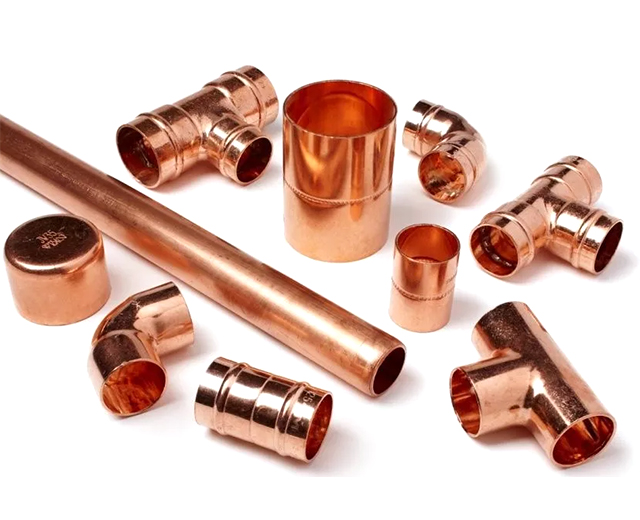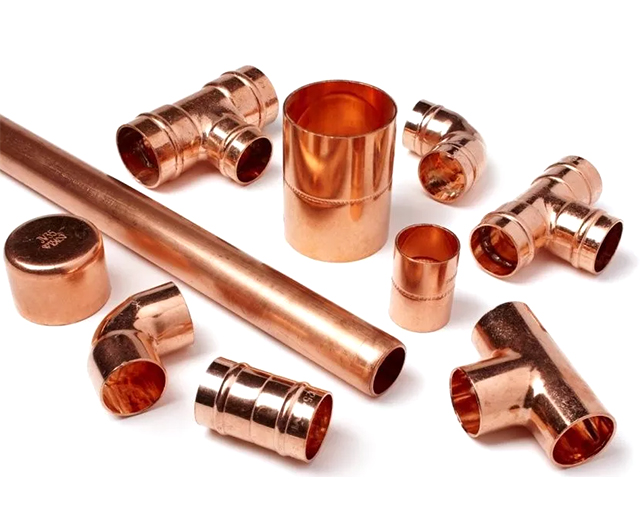

Copper Bus Pipe is a specialized hollow conductor made of high-conductivity copper, designed for use in medium to high-current electrical power systems. Compared to traditional flat busbars, Copper Pipe Busbars offer enhanced current-carrying efficiency due to the skin effect, making them an ideal solution for energy-intensive environments such as substations, industrial plants, renewable energy systems, and rail networks.
Also known as Copper Bus Tubes, these cylindrical conductors combine mechanical durability with excellent electrical performance, and are increasingly popular in both professional installations and DIY Copper Busbar projects.

Material: High-purity copper with minimum 100% IACS conductivity
Current Rating: 600A to 5000A depending on dimensions (e.g., 25mm OD × 3mm wall to 150mm OD × 10mm wall)
Thermal Resistance: Continuous operation up to 90°C, short-term withstand up to 250°C
Mechanical Strength: Tensile strength from 200 MPa (annealed) to 450 MPa (hard-drawn)
Corrosion Resistance: Natural Cu₂O patina with low atmospheric oxidation rate
Customization: Available in round or square profiles, with tin plating or insulation upon request
Substation Power Transmission
Large-diameter Copper Bus Pipes (80–150mm OD) are widely used to carry currents up to 5kA between transformers and switchgear. Their circular shape improves current density by up to 20% compared to equivalent flat bars.
Industrial Bus Duct Systems
In factory feeders, Copper Pipe Busbars with 6–12mm wall thickness provide stable current flow while allowing natural cooling. This helps keep temperature rise below 35K even under heavy loads.
Solar and Renewable Energy
Copper Bus Tubes with 50mm OD are used in combiner boxes to handle DC currents of 1000–2000A. Their hollow design minimizes voltage drops and heat buildup in solar plants and battery energy storage systems.
Railway Electrification
Used in 25kV AC systems, these pipes deliver efficient overhead power with 40% lower impedance compared to aluminum conductors, offering a reliable solution for mass transit infrastructure.
High-Frequency Applications
In RF environments above 1MHz, copper’s skin depth becomes critical. Pipes outperform solid bars by concentrating conduction on the outer layer, improving system efficiency.
For those considering how to use copper pipe as a bus bar in custom or DIY systems, follow these best practices:
Mounting: Secure using insulated saddles or sliding brackets to account for thermal expansion.
Bending: Maintain a bend radius of 2–3× pipe diameter using mandrel bending tools to avoid deformation.
Jointing: Use compression flanges or welded sleeves. Apply antioxidant paste and torque bolts to recommended specs.
Grounding: Ensure redundancy and mechanical strength—ground paths should be at least 50% of the phase conductor size and rated for 30kA withstand.
Cooling: Allow airflow around the pipe; no need for forced cooling in most applications due to natural convection efficiency.
Even in DIY Copper Busbar setups, these guidelines ensure electrical integrity, safety, and longevity.
Monthly: Visual checks for discoloration or damage
Annually: Test bolted joint contact resistance (<20μΩ recommended)
Every 2 Years: Perform ultrasonic wall thickness testing (>2mm minimum)
Every 5 Years: Conduct 2.5kV dielectric strength testing on insulated sections
Regularly: Clean surface oxidation with citric acid or commercial copper cleaner; coat with corrosion inhibitors for coastal or humid conditions
Thermal Scanning: Use infrared thermography to detect hotspots (alert if >65°C above ambient)
In vibration-prone environments, install dampers and confirm resonance frequency remains above 30Hz to prevent fatigue.
Superior Conductivity
Better performance than flat bars at high frequency due to current concentration on the outer surface.
Excellent Thermal and Mechanical Performance
Can handle extreme load and temperature conditions without deformation or conductivity loss.
Durable and Corrosion-Resistant
Requires minimal surface treatment in most environments.
Customizable and Versatile
Suitable for commercial, industrial, utility-scale, or DIY Copper Busbar applications.
| Outer Diameter | Wall Thickness | Current Rating | Material | Surface Finish |
|---|---|---|---|---|
| 25 mm | 3 mm | 600 A | Pure Copper | Bare / Tinned |
| 50 mm | 5 mm | 1500 A | C11000 | Bare / Insulated |
| 100 mm | 8 mm | 3500 A | Hard-Drawn Copper | Tinned |
| 150 mm | 10 mm | 5000 A | C10200 | Plated |
Custom sizes, plating, drilling, and assembly services are available upon request.
Copper Bus Pipe is used as a rigid, high-conductivity conductor in electrical power systems. It serves as a central path for distributing high current in substations, industrial facilities, solar energy plants, and railway electrification systems. Its hollow design also improves heat dissipation compared to solid bars.
The Copper Pipe Busbar is cylindrical and hollow, whereas flat busbars are typically solid rectangular strips. Due to the skin effect, current tends to flow on the outer surface of conductors at higher frequencies—giving pipe busbars better performance in RF and AC power systems.
Yes. Many engineers and electricians use DIY Copper Busbar setups with copper pipe for custom battery packs, solar combiner boxes, and experimental energy storage systems. Just ensure proper jointing, insulation, and thermal management during installation.
Sizes typically range from 25mm to 150mm outer diameter, with wall thickness from 3mm to 10mm. Current ratings range from 600A to 5000A depending on size and installation conditions. Custom specifications are also available upon request.
Tinning or nickel-plating the Copper Bus Pipe is recommended for environments with high humidity, industrial pollution, or coastal exposure. It enhances corrosion resistance and maintains surface conductivity over time.
You can connect pipes using compression joints, welded sleeves, or flanged connections. For bolted joints, use antioxidant compound and torque bolts to specification (e.g., 25–30 N·m for M10). Always check contact resistance annually.